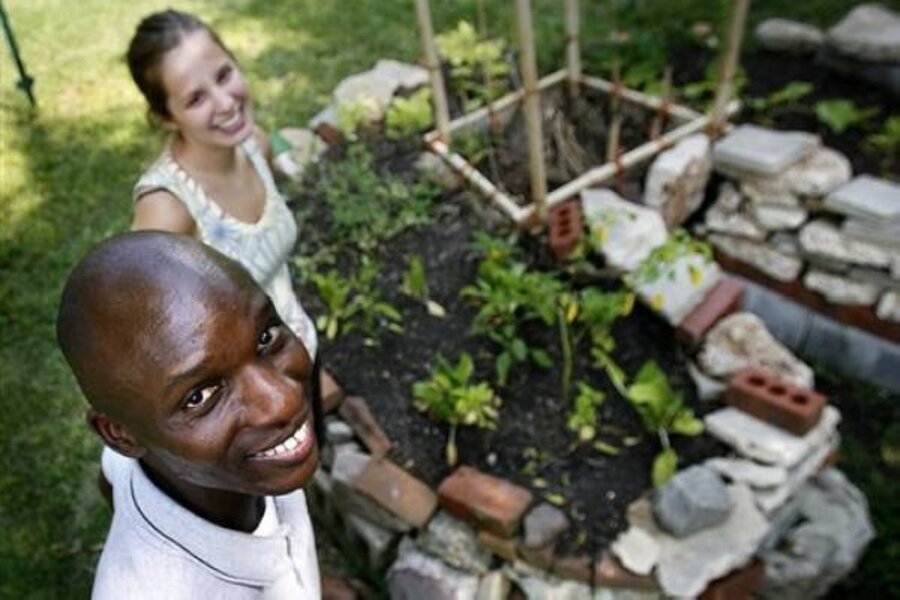Keyhole gardens: a sustainable, traditional way to grow food
Loading...
| Richmond, Va
Not every backyard vegetable garden has to be on a flat plot of land with plants lined up in neat rows. Plants can be tucked in flowerbeds. They can be grown in pots or tucked into burlap bags hung on a fence.
A keyhole garden, a type of raised garden that occupies less space and is more accessible, is one option that's getting some buzz among people who support gardening techniques that are environmentally friendly and require fewer resources.
Edible-landscape designer Marlene Sehen helped a group of volunteers create a keyhole garden at the William Byrd Community House in Richmond, Va. The keyhole garden gets its name from its shape. From above, it looks like a keyhole. For best access, they are built just a few steps from the home.
"It's raised and you can access it through the center area," Ms. Sehen says. "The center part is a compost pile. With it being close to the house, you can come out with your vegetable clippings and put those in. The soil that's within the raised area is composed of straw, manure, soil, and we also used a good deal of compost."
"It's a more sustainable system than some of your typical gardening we do here — regular in-ground planting," she adds.
"When you get into sustainable gardening, you are focusing on what resources you have available.," says Sehen, who works full time at the Federal Reserve Bank of Richmond, maintaining interior and exterior plants. "You don't have to use up a lot of resources or have resources brought in to keep it going. It can maintain itself with what's around."
Sustainable-gardening techniques also don't deplete the land.
Keyhole gardens fit in with the permaculture concept of creating gardens that are permanent and blend in with the landscape, unlike traditional gardens that are turned or plowed under after the growing season.
Sehen says she learned about keyhole gardens last year when she was preparing for a trip to Africa. She didn't see any in Ghana, where she traveled, but she liked the idea enough to try to replicate it.
Send A Cow, a charitable group in Britain, has promoted the idea of keyhole gardens in Lesotho in South Africa as a way for families to maintain a source for food year-round.
In areas of Africa where families still have to tote water, the proximity of keyhole gardens makes it easy for wastewater to be used to water the garden.
The walls that form the structure of the garden at the Byrd House are made from stone and bricks gathered over about a month, Sehen says. "From trash piles, wherever we could find it."
The walls were built to a height to be easily accessible by the schoolchildren participating in Byrd House after-school programs.
As the center pile of compost breaks down, it leaches nutrients to the soil. "Roots will tend to find water. They move toward it, once they get established," Sehen says.
Byrd House volunteers Abner Nyandege and Chris Stitzer helped with the project — both working with schoolchildren who planted vegetables in the keyhole garden and in another bed nearby they called the pizza garden because they planted pizza ingredients.
"The kids had an after-school project to work on a garden that is exotic, a garden that is not being practiced in the United States," Mr. Nyandege says. He visits the keyhole garden during the Byrd House Market on Tuesdays to tend to the plants and talk to visitors curious about the design.
"Another advantage is it looks beautiful," Nyandege says. "It's pleasant to look at compared to the common boxlike garden. And it has an organic recycling tank."
As the children worked on the project, they learned about its role in reducing hunger in some places, says Stitzer, who was a teacher in the after-school program and is volunteering this summer.
"We try to emphasize empathy, empathy for the things we are growing, for the environment, for the people we are growing these for," says Stitzer. "It helps the kids understand that there are things bigger than them."
Editor’s note: For more on gardening, see the Monitor’s main gardening page. Our blog archive. Our RSS feed.You may also want to visit Gardening With the Monitor on Flickr. Join the group (it’s free) and upload your garden photos. Join the discussions and get answers to your gardening questions.





